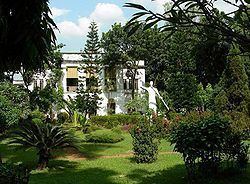 | ||
Bhawal Estate (Bengali: ভাওয়াল) was a large zamindari estate in Bengal in modern-day Bangladesh. Bhawal Estate spread over 579 square miles (1,500 km2) and covered 2,274 villages with the combined population around 500,000, many of them tenant farmers.All the rulers and holders of this estate were Srotriya Brahmin. It gained particular notoriety during the famous Bhawal case.
The area under the estate currently falls under the Gazipur District and the Upazilas of Bangladesh Kaliganj of Dhaka Division. The most famous capitol of the Bhawal Estate was Choira Meah Bari, where zamindar Fazal Gazi lived. He was one of the Baro-Bhuyans (twelve zamindars of Bengal).
Before the Mughal conquest, Bhawal Estate belonged to Gazis of Bhawal. The first known Gazi was Fazal Gazi, who lent a cannon to Sher Shah Suri with 'Az Fazal Gazi' (from Fazal Gazi) inscribed on it. Bahadur Gazi was in control during Akbar's invasion. Gazis accepted Mughal suzerainty during Subahdar Islam Khan's final conquest and rule of Bengal. Gazipur District was named after the Gazis of Bhawal.
The Rajas of Bhawal came from the village of Bajrayogini under Munshiganj. Bala Ram, the ancestor of the Rajas of Bhawal, was Dewan to Daulat Gazi at the time of Murshid Kuli Khan's reign in the late seventeenth century. As a policy to collect proper and due revenue, Murshid Kuli Khan replaced many Muslim zamindaris with Hindu ones. Dewan Bala Ram took the opportunity and convinced Murshid Kuli to install his son, Sri Krishna, as the zamindar of Bhawal in 1704 instead of Daulat Gazi. His family ruled Bhawal until the abolition of the zamindari system in 1951 at Choira Meah Bari, which was the capital of Bhawal.
